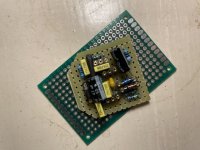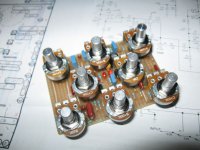uranium_jones
Well-known member
So, over the weekend I just made a Big Muff modeled after the Violet Ram's Head schematic. That may not be so noteworthy, but it is my first time using veroboard, which I wouldn't have even heard of if it weren't for this community and in particular @Chuck D. Bones. This was also the first time I could ever build my circuit using parts I had on hand rather than waiting on a Tayda order. I think that's probably a sign that this is my life now.
layout: http://tagboardeffects.blogspot.com/2012/06/ehx-73-rams-head-big-muff.html
schematic w/ Violet values: http://www.bigmuffpage.com/images/KR_1973_V2_Violet_Schematic_1st_version.jpg
from the page kitrae.net/music/big_muff_history1.html
Here are some of my thoughts about the whole "vero" thing.
Pros:
Also, first time I hand-painted a graphic, and used a letter stamp kit for the bare enclosure. Highlights the fact that this was really made from scratch.
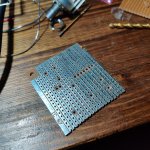
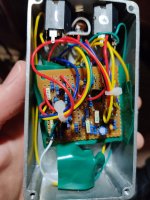
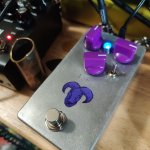
layout: http://tagboardeffects.blogspot.com/2012/06/ehx-73-rams-head-big-muff.html
schematic w/ Violet values: http://www.bigmuffpage.com/images/KR_1973_V2_Violet_Schematic_1st_version.jpg
from the page kitrae.net/music/big_muff_history1.html
Here are some of my thoughts about the whole "vero" thing.
Pros:
- just grab a board and get to work! No waiting on shipping or if a particular PCB is in stock.
- you get more intimate knowledge of the circuit by having to assemble the whole thing from nothing.
- Easier to try mods since there are probably extra holes to tie into the circuit.
- If you are designing your own circuit (someday!) there's no need to learn complicated PCB-making software.
- A lot of time spent on double-checking you're putting the right component in the right spot.
- far more wires since the potentiometers are not mounted to the board. Not a lot of opportunity to make them shorter the way I did it. Maybe I can work on this in the future to get the box less crowded.
- the board is "floating" and all the traces are exposed - more potential for shorts. I ended up coating the strip side with old electrical tape.
Also, first time I hand-painted a graphic, and used a letter stamp kit for the bare enclosure. Highlights the fact that this was really made from scratch.





